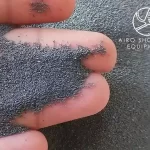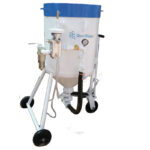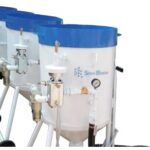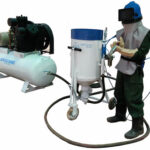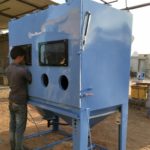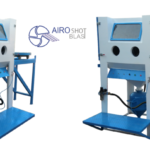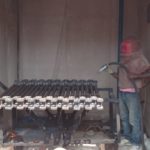
Wire arc spray is a kind of thermal spraying where two consumable metal wires are supplied independently into the arc spray gun. These wires are suddenly charged and an arc is generated between them. The heat from the arc melts the incoming wire, which is then entrained in an air jet from the gun. This entrained molten feedstock is then deposited onto a component with the help of compressed air. This process is usually used for metallic, heavy coatings.
For melting the coating material both flame also electric arc process is utilized. The electric arc process of a metal spray gun, the arc is generated between the cathode and anode. In metalizing gun coating material having opposite polarity is used.
In the electric arc process, two methods are used to forward the coating wire. One is an air drive and the other is an electric arc drive. The air drive, compressed air is used to forward the wire in electric drive, a motor is applied to forward the wire which is connected to the electric panel.
In the flame type, compressed air is utilized with oxygen also acetylene gas to melt the coating matter. Thermal spray gun LPG gas is also applied sometimes at the place of acetylene with oxygen.
Arc spraying procedures are coating processes in which melted (or heated) materials are sprayed toward a surface. The “feedstock” (coating precursor) is warmed through electrical (plasma or arc) or chemical means (combustion flame).
The arc spray gun can provide thick coating (approx. thickness range is 20 microns to various mm, depending on the process also feedstock), over a large area at a high removal rate as compared to other coating methods such as electroplating, physical including chemical vapor deposition. Coating materials available for thermal spraying include metals, alloys, ceramics, plastics, also composites.
They are supplied in powder or wire form, heated to a molten or semi-molten state furthermore accelerated towards substrates in the formation of micrometer-size particles. The flaming or electrical arc discharge is usually utilized as the source of energy for thermal spraying. Resulting coatings are made by the collection of numerous sprayed particles. The surface may not heat up significantly, allotting the coating of flammable substances.
Coating quality is usually estimated by measuring its porosity, oxide content, macro micro-hardness, bond strength also surface roughness. Usually, the coating quality increases with increasing particle velocities.
There are three operating controls in the Metal Gun:
1. The gas head device controls the flow of gases also air both the gas head and the drive turbine.
2. The speed control rings adjust the rate of wire feed.
3. The wire valve thumb-slide (trigger) causes the drive rolls to grip or release the wire.
Process Steps of an arc spray gun
- Part Cleaning/Degreasing
- Masking
- Surface Preparation of surfaces to be coated
- Blasting
- Demasking/Cleaning
- Masking/Preparation for Coating
- Coating
- Demasking
- Secondary operations such as deburring or finishing
- Inspection & Testing
Features of the arc spray gun
- Very efficient and reliable
- High performance
- Easily utilized
- Cost-effective
